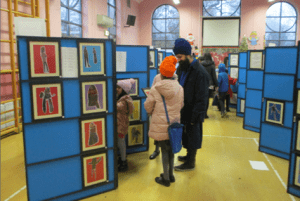Art
OUR ASPIRATION FOR EVERY LEARNER:
At Khalsa Primary School we believe Art is for life. We work passionately to facilitate all learners to grow in their love of Art, Craft and Design, giving them the confidence to explore and develop their creativity. Art is both a form of communication and a means of expression of ideas and feelings. The studying of Art develops technical skills and offers the prospect of research, analysis, discussion, experimentation and risk-taking – leading to independent learning. It forms a creative language which complements those of the literary, mathematical, scientific and factually based subjects. Learning Art at Khalsa Primary School is liberating, challenging and exciting.
We have designed a bespoke, accessible curriculum, promoting learning of artists and designers from diverse backgrounds, including those local to us in Slough/Berkshire. We develop global citizens who are knowledgeable about Art, Craft and Design from around the world. Our Art curriculum enables them to be articulate, caring, world changing individuals.
Pupils should have the capacity and opportunities to be fluent in their art. They learn specific Art skills early in their school career, so that they can test limits and reach original solutions when they get to upper KS2. Pupils progress throughout their school career, leading up to them beginning to investigate their own journey within a theme, making personal choices about which materials and media they want to use. We aim for our pupils to grow from novices to experts. As pupils move into upper KS2, they are well equipped with a solid foundation of Art knowledge, allowing them to progress as individual artists. Some of the previous scaffolding will be reduced in order for pupils to begin to explore more open-ended activities. This enables teaching to build on previous learning by offering more complexity and further opportunities to experiment. Automaticity is gained by the end of KS1 – meaning pupils are not consciously thinking about how to implement their practical knowledge. This results in pupils having the confidence and freedom to use their built schemas effectively and think imaginatively in their work.
“Art is not what you see, but what you make others see.” Edgar Degas
The National Curriculum for art and design aims to ensure that all pupils:
- produce creative work, exploring their ideas and recording their experiences
- become proficient in drawing, painting, sculpture and other art, craft and design techniques
- evaluate and analyse creative works using the language of art, craft and design
- know about great artists, craft makers and designers, and understand the historical and cultural development of their art forms
Key stage 1
Pupils should be taught:
- to use a range of materials creatively to design and make products
- to use drawing, painting and sculpture to develop and share their ideas, experiences and imagination
- to develop a wide range of art and design techniques in using colour, pattern, texture, line, shape, form and space
- about the work of a range of artists, craft makers and designers, describing the differences and similarities between different practices and disciplines, and making links to their own work
Key stage 2
Pupils should be taught to develop their techniques, including their control and their use of materials, with creativity, experimentation and an increasing awareness of different kinds of art, craft and design.
Pupils should be taught:
- to create sketch books to record their observations and use them to review and revisit ideas
- to improve their mastery of art and design techniques, including drawing, painting and sculpture with a range of materials
- about great artists, architects and designers in history
WHAT WE DO TO ACHIEVE OUR ASPIRATIONS:
At Khalsa Primary School we have carefully sequenced the use of a range of materials for pupils to explore, in order for them to have opportunities to practice their skills and begin to master techniques. Each year they learn and remember more about the Art techniques and theories learnt, resulting in them being able to do more.
We focus on the three main National Curriculum skills of drawing, painting and sculpture, but also have a drive to ensure pupils are exposed to printing, collage, photography and digital Art by the time they leave us. Within each Art discipline, pupils build upon their previous methods and techniques, using a wide range of media to experiment and try new ideas. Pupils are taught specific technical language, which encourages richer reflections and discussion, where pupils become the experts in their field of study.
We broaden pupils’ ideas of what Art is by exposing them to a diverse range of artists and contextualizing works of Art within history. Placing Art within a historical timeline supports pupils in building their schemas of why Art is important and how it is used for a variety of reasons.
Pupils learn about Art beyond the classroom by participating in local initiatives, having skilled visitors for workshops, and experiencing school trips to high profile Art institutions. We aim for our pupils to experience at least two activities inspired by Art – external visits or workshops – by the time they graduate in Year 6.
We value Art and Design and promote it at home through invitations to join in with holiday projects and term time competitions. We organise and host whole-school Art Exhibitions to celebrate all pupils’ achievements in an Art unit. Families are welcomed and encouraged to visit too, where they can purchase their child’s unique framed artwork.
Transferable skills from Art, such as drawing, are used across the curriculum and reflected in our ambitious corridor displays. High expectations for all allow us to achieve inspiring displays of work, created by students with different abilities across all years. We have a permanent Art Gallery Exhibit in our central corridor, which reflects termly projects from KS1 and KS2. EYFS have their own permanent Art Gallery Wall, which values the work they have contributed to Art in that term also.
Art and Design is led by an expert subject specialist, who is skilled to lead quality and bespoke training sessions for all staff. This enables teachers to have the knowledge and confidence when they model techniques to the pupils and encourages them to use technical language when describing processes and materials.
WHAT WE DO TO MEASURE OUR SUCCESS:
In Key Stages 1 and 2, pupils are assessed against the National Curriculum objectives. Teachers use these objectives to inform planning and give timely verbal feedback within practical lessons, to coach pupils according to each objective.
Teachers use progression documents to assess whether their learners are working within their age-related expectations for Art and Design. As well as key skills and objectives relating to creativity and techniques, success is also measured largely by the effort and engagement level of each pupil. This ensures achievement for all pupils, no matter their starting point.
Pupils have numerous opportunities to share their work within the class and also across the school, for example in Art Exhibitions and displays. This helps to validate and celebrate their outcomes and showcase the hard work they have put into creating a high-quality final outcome. Sketchbooks are also peer assessed so that good practice can be promoted, praised and encouraged across the cohort. We use sketchbooks to assess in KS1 as well as in KS2.
Pupils self-assess their learning throughout the Art journey in their sketchbooks. This takes the form of reflective annotations and comments. These annotations reflect the technical vocabulary and language used within each unit, which further supports the teachers’ judgements of how successful a pupil is within the subject.
Pupils’ understanding of artists is measured through their research pages in their sketchbooks and pupil voice monitoring by the subject leader. Artists are referred to from previous learning to assess pupils’ knowledge acquisition.
Our success is also measured holistically, where conversations and aspirations echo a pupil’s love of the arts and STEAM. Many of our pupils aspire to study creative subjects at a higher level and even wish to pursue STEAM careers in the future.
Pupils grow into confident, reflective artists who are able to discuss their personal learning journey referring to the current moment or linking to previous units – whether in the previous week, term or year. Speaking and listening opportunities are embedded within evaluations of a unit, which allows us to assess how successful each pupil is with their learning.
Sketchbook example of how pupils are taught specific practical knowledge, e.g. colour theory, but are also given the freedom to explore materials (watercolours) and choose how they wish to display their learning for the most visual effect.
Whole school Art Exhibition inviting all parents to observe their child’s work and also purchase it to display at home – involving PTA and raising the status of Art.
Teachers participating in a CPD session about embroidery and sewing skills.



